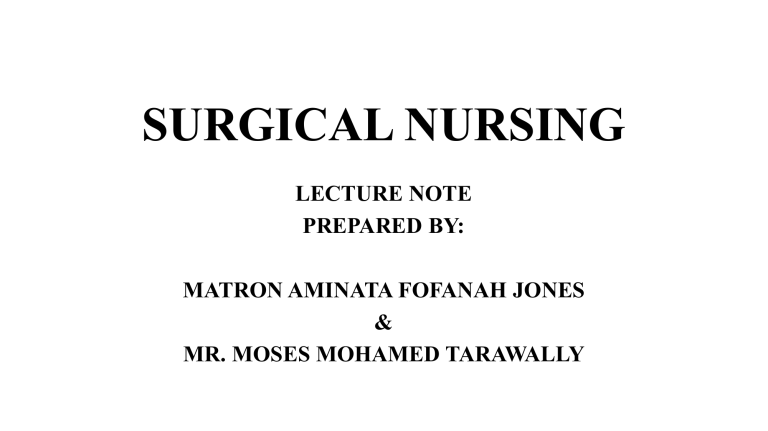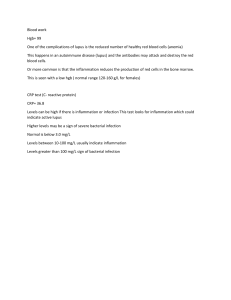
SURGICAL NURSING LECTURE NOTE PREPARED BY: MATRON AMINATA FOFANAH JONES & MR. MOSES MOHAMED TARAWALLY INFLAMMATION INTRODUCTION • Inflammation is necessary for the survival of the host. • In the absence of inflammation the body would be unable to kill and eliminate infectious agents. • One of the innate defense mechanisms of the body. • The survival of organisms depends on their ability to get rid of damaged or necrotic tissues and foreign invaders, such as microbes. • The host response that accomplishes these goals is called inflammation. DEFINITION • It is the reaction of body tissues to an injury or an irritant. • Inflammation to a specific tissue is denoted by the suffix "ITIS", following the name of the tissue. Example: Appendicitis, cholecystitis, peritonitis and gingivitis etc. CAUSES • Physical agents – heat, cold, radiation, mechanical trauma • Chemical agents – organic and inorganic poisons • Infective agents – bacteria and virus • Immunological agents – cell mediated, antigen-antibody reactions (hypersensitivity reactions) SIGNS AND SYMPTOMS The cardinal signs of inflammation are; • Rubor (redness) • Tumor (swelling) • Calor (heat) • Dolor (pain) • Functio lasea (loss of function) ENGLISH LATIN CAUSED BY Redness Rubor Hyperemia Warmth/heat Calor Hyperemia Swelling Tumor Increased vascular permeability Pain Dolor Nerve stimulation, Low pH Loss of function Functio Lasea Pain, swelling Other symptoms may include: • General malaise • Anorexia • Headache • Fever • Lethargy • Weakness • Increased ESR TYPES OF INFLAMMATION There are two main types of inflammation: Acute and Chronic • ACUTE: Initial, rapid response to infections or tissue damage. It is typically of short duration, from days to few weeks and may range from mild to very severe depending on the extent of tissue damage. • CHRONIC: Prolonged response in which tissue injury, and repair coexist in varying form. It is of longer duration and considerably more tissue damage is likely. PATHOPHYSIOLOGY OF INFLAMMATION When damage or irritation of a tissue occurs, there is an initial response of vasoconstriction at the site. After a while, there is progressive vasodilation which results into gush of blood and inflammatory mediators (like Histamine, Serotonin, Prostaglandins, Bradykinin and substance P), to the site (Hyperemia), this results into redness and warmth at the site. Increase vascular permeability leads to transudation of fluid into extracellular spaces leading to swelling at the area. Stretching of nerve endings results into pain. Pain and swelling at the affected site leads to loss of function in that area. SYSTEMIC EFFECTS OF INFLAMMATION 1.Fever 2.Leucocytosis (High levels of WBC count) 3.Lymphadenitis (swollen lymph nodes) 4.Shock FATE OF ACUTE INFLAMMATION 1. Resolution 2. Healing by scarring 3. Progression to suppuration 4. Progression to Chronic inflammation. NURSING MANAGEMENT • Adequate rest: to help the body build adequate defense mechanisms and decrease the energy expended by the patient. • Application of heat or cold: heat causes relaxation of muscles, facilitating blood flow. Cold constricts blood vessels, reduce volume of exudates and the degree of swelling. It lessens pain and prevents the growth of bacteria (when it’s a cause) NURSING MANAGEMENT • Promote and maintain the nutritional status: to meet the increased energy demand and tissue catabolism, support the development of fibrous tissues, and promote growth of new tissues • Prescribed medications should be administered • Surgical wound dressing to be done (in the presence of an open wound): to promote healing TREATMENT Treatment of inflammation will depend on the cause and severity. Sometimes, treatment is actually not required. A doctor may prescribe treatment to remove the cause of the inflammation, manage symptoms or both. Here are some treatments specifically for treating inflammation; 1. Nonsteroidal anti-inflammatory drugs (NSAID): they help relieve pain, swelling and fever. They do this by countering the action of an enzyme that contributes to inflammation. Eg, Diclofenac, Ibuprofen, Naproxen, Aspirin etc. (NOTE: NSAIDs will not remove the cause of the inflammation) 2. Pain relief: These drugs allow the inflammation to continue its role in healing. They can relieve pain but does not reduce inflammation. Eg, Paracetamol, all Opioids. 3. Steroidal anti-inflammatory drugs (Corticosteroids): They affect various mechanisms involved in inflammation. Eg, Dexamethasone, Hydrocortisone, Prednisolone etc. Long-term use of steroids can be harmful as they have potential of suppressing the immune system, amongst others. 4. Antibiotics or Antifungals: Can be given if the cause of the inflammation is a bacterial or fungal infection. THANK YOU






